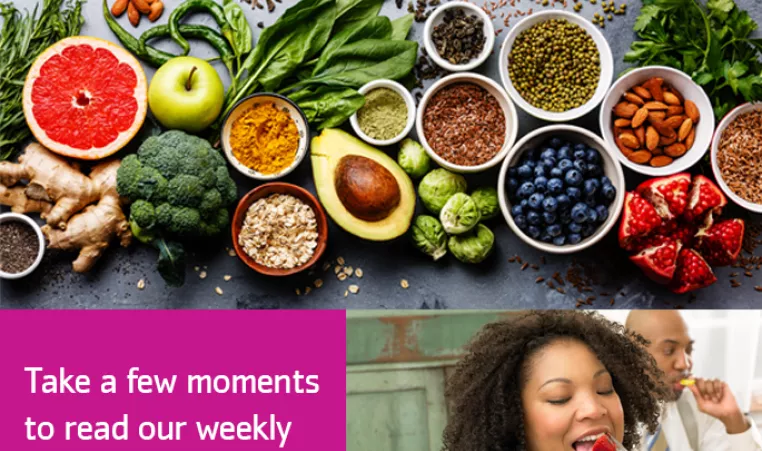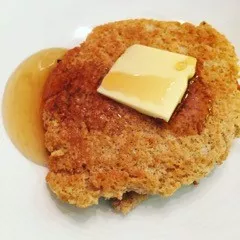
“Go Further with Food”
By Registered Dietitian Nutritionist, Marina Bedrossian
Starting the day off right with a healthy breakfast is my favorite way to go further with food. A hearty breakfast will last you past noon with ample energy.
Many people I speak to are ashamed to admit they skip breakfast, and it is usually due to one of the following reasons:
1.) No appetite
2.) Lack of time
3.) Lack of energy
Let’s look into solutions for these problems…
1.) No appetite: A poor appetite in the morning can be due to eating too much and too late the night before. Try having smaller portions at dinner and avoid snacking after dinner. You should not feel “full” when going to bed, and ideally you will have at least 2 hours to digest your food before hitting the pillow. Secondly, try drinking 8-16 oz of room temperature or warm water when you first wake up. This will not only hydrate you, but will wake up your metabolism. Hydration is key to proper digestion!
2.) Lack of time: Some mornings are rushed—especially if you have young children. But would you skip dinner if evenings were rushed? Eating breakfast on the go is an option. Trail mix—and not the kind with the M&Ms :) — is a perfectly wholesome, portable meal which does not require any preparation. Lower sugar or plain Greek yogurts, no salt added cottage cheese, and even ricotta cheese can be enjoyed alone or with fruit and seeds.
3.) Lack of energy: Not a morning person? Try preparing your breakfast the night before, along with your lunch ;-) You can also make a frittata or “egg muffins” at the beginning of the week. Overnight oats can be made the night before by mixing raw oats, yogurt, milk, and fruit and topped with some nuts. What about a smoothie? These can be perfect for those with no appetite, lack of time, AND lack of energy! Be sure not to over-do the fruit here, and add a source of protein.
My Favorite breakfast additions:
- VEGETABLES are often left in the dust when it comes to breakfast. Raw veggies like cucumbers, tomatoes, carrots, peppers & fennel are potable and require minimal preparation. Otherwise, I use leftover veggies to have on the side of my eggs or mixed in an omelette.
- FRUIT is high in carbohydrates & fiber, a great source of sustained energy. My favorites are fresh fruit, dried fruit (look for no sugar added), frozen fruit. Be cautious with the serving sizes when it comes to dried fruit, it may be less than you think! Frozen fruit is a great way to enjoy varieties which are out of season.
- PROTEIN will keep you full, longer. I love eggs because they can be cooked in 2 minutes. They can be hard cooked for a grab-and-go kind of morning, soft cooked, poached, scrambled, over easy, sunny side up, made into an omelette, or baked into a quiche. They also go well with vegetables.
- Plain or low-sugar varieties of Greek yogurt are also high in protein. I always look for brands with the fewest ingredients and least sugar, with the most protein and biggest serving size.
- Cottage cheese is another protein super-star. Don’t like the texture? Throw no salt added cottage cheese into your blender, and it will quickly resemble ricotta cheese.
- Nuts & seeds are good sources of protein, but often contain more calories per gram of protein than the above options, with many of the calories coming from fat. WHICH IS PERFECTLY GREAT if you’re not looking to cut calories. Otherwise, use nuts and seeds, but be sure to measure the serving sizes.
- Fish: A much less popular breakfast choice in the US, but think about cream cheese & lox for a minute—YUM! You can use a thin whole grain cracker with a small schmear of cream cheese or grass-fed butter, layered on top with wild smoked salmon. Top with red onion, dill, or cucumber. Canned sardines also make for a great meal on a cracker with mustard or horseradish. Talk about super foods!
- Meats: Most breakfast sausages and bacons are highly processed and are warned against by the American Cancer Society. However, carefully sourced sausages and bacon can fit into a healthy breakfast. Three ounces for meat for women and six ounces for men is plenty. Also, consider leftovers from the night before. How about jerky? If you are thinking outside of the box by eating these foods for breakfast, do yourself a favor and fill the other 50%-75% of your plate with vegetables.
- Plain or low-sugar varieties of Greek yogurt are also high in protein. I always look for brands with the fewest ingredients and least sugar, with the most protein and biggest serving size.
- MILK ALTERNATIVES are quite popular. They are useful for those with sensitivities and allergies to animal milk, although often have much less protein and more added sugar. My favorite way to make my own nut milk is to soak the nuts in water overnight (can be kept in the refrigerator for a week), then add them to some fresh water in the blender and blend until smooth. This works well with raw cashews, pecans, almonds, and macadamia nuts. You can strain the milk with a cheesecloth to remove the fiber if desired, and store for up to 3 days in the refrigerator.
- OATS provide heart- and colon-healthy fibers. Old fashioned, steel cut oat, and oat bran have more fiber and can be used for different purposes. I love oat bran pancakes, or simply cooked oat bran with water and a dash of salt.
